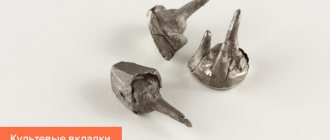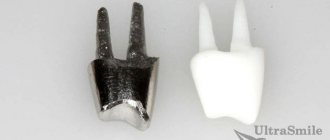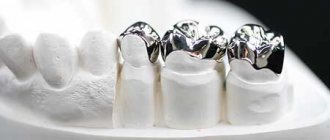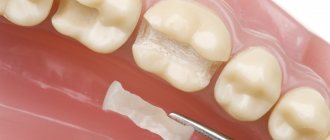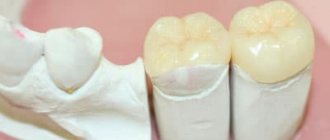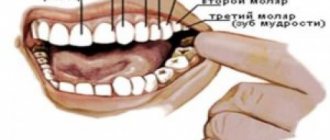If a tooth is destroyed by caries or as a result of injury, it must be restored, otherwise the tooth can be lost, and the absence of even one dental unit in a row is fraught with the most unpleasant consequences for health. For example, due to the absence of a tooth, an incorrect bite may develop, which leads to disruption of the correct process of chewing food and the development of various diseases of the digestive system.
If the tooth is slightly damaged, then most likely the doctor will use a regular, light-curing filling to restore it. But if the damage is significant, it would be more correct to use a stump tab.
Many people do not even know what kind of structure this is - a stump tab and for what purpose it is used by dentists. Meanwhile, the use of stump inlays makes it possible to successfully restore teeth that at first glance seem completely hopeless and must be removed.
In the article we will tell you in detail about what stump inlays are, what types of them exist, and why severely damaged teeth are best restored with inlays, and not with fillings and pins.
What is a stump tab and why is it needed?
A stump inlay is not a filling or a seal on a post. This is a specialized orthopedic design that is produced in a dental laboratory and is used to restore teeth that have been more than half destroyed by caries or trauma.
Of course, even a badly damaged tooth can be restored with a filling on a pin and then a prosthesis can be placed on it. But such an approach to prosthetics will be wrong, since large fillings, even if attached to pins, are simply not capable of holding well. The load on the tooth will sooner or later lead to the filling on the pin falling out along with the prosthesis, and then the tooth will have to be re-treated.
Stump inlays help to avoid such unpleasant consequences - they are firmly fixed in the root canal of the tooth and the dental crown is fixed on them. Externally, the inlays are very similar to stumps - ground teeth - hence their name.
What are the alternatives?
If there is a volumetric lesion of the coronal part of the tooth, there are only four options for prosthetics. The first is the tabs themselves. The second is filling, but a large filling may not withstand the load, and there will be too few tooth walls for the composite material to adhere to, so it will be short-lived. The third method is to install a crown. But this option is an extreme option, when other methods are no longer effective. The fourth method is tooth restoration on a pin: a metal rod is installed inside the root, which serves as a support for restoring the coronal part (using an artificial crown or composite build-up). This option is cheaper, but less durable, and the pin can lead to root fracture.
1 Shcherbakov A.S., Gavrilov E.I. Orthopedic dentistry. Ed. Folio, 1998.
Why are core inlays better than fillings and pins?
Fillings and pins are only applicable if the tooth has a sufficient amount of healthy tissue remaining. If only the root or thin walls of the tooth remain, then it cannot be restored with a pin, since such a restoration method will not be distinguished by either quality or reliability.
Firstly, under load, the pin can break and in the process damage the tooth root. Trauma to the root of a tooth is a direct indication for its removal; no methods for damaging the root system will help you save your tooth.
Secondly, dentures installed on large fillings and pins most often fall out some time after prosthetics. In this case, the treatment will have to be carried out again, and this implies new and significant financial costs.
IMPORTANT: Some dentists try to fix the fallen crown and pin with cement. But this is useless: the structure will not hold firmly, and in addition, an inflammatory process may begin under it, leading to rotting and destruction of the tooth.
Therefore, in case of severe tooth decay, only a stump inlay can provide high-quality and durable prosthetic results.
Classification of restorative prostheses
An accessory of this type is installed by dentists if the coronal part is slightly damaged. For this, metal, metal-free ceramics and others are used.
Metal
Most often the composition includes gold, as well as alloys (chrome-cobalt, silver-palladium). At first it may seem that this is aesthetically unattractive, but the structures are located on the chewing teeth, invisible to the prying eye even with a wide smile.
This type is much more reliable than composite fillings, which is why it is preferred on the European and American continents. Each type should be considered in more detail.
- Gold. They are considered the best in many respects. The metal used in production is not the traditional 585 (found in most jewelry), but 900 and higher (gold leaf). The raw materials used are relatively soft, which creates minimal gaps and significantly increases service life.
- Alloys. They cost much less than the previous option, but they also last less. But such dental inlays still have advantages over fillings (compared to short-lived composites) and are considered more reliable.
All-ceramic
There are two types: zirconium dioxide and pressed ceramics. The first is produced by milling from zirconium blanks. The manufacturing process is as follows:
- removal of all tissues damaged by caries using a drill, creating a cavity of a certain shape;
- taking an impression of the jaws and constructing a plaster model of the upper and lower rows;
- scanning and constructing a three-dimensional projection of the future product;
- automatic cutting of the accessory using a milling machine according to specified parameters;
- firing of the restoration element, fusing of porcelain;
- fixation in the oral cavity.
The main advantage of zirconium is the absence of the human factor in the manufacture of the part, since the process is almost completely automated. The durable frame is not inferior in reliability to a metal one.
Pressed ceramics are produced by injection molding porcelain mass at elevated pressure and high temperatures. This way you can achieve ideal smile aesthetics.
Metal-ceramic
It is not surprising that such an inlay is quite rare in dental treatment at the dentist. It costs the same as ceramic products, but is not of good quality.
A significant problem is the loss of installed elements. This is due to different coefficients of thermal expansion between metal and ceramics.
Composite
This type was used everywhere some time ago. The product is made from conventional filling composites, but not in the patient’s mouth, but in a special laboratory. The quality characteristics are exactly the same as those of fillings, but such an accessory costs a third more. It turns out that there is no point in overpaying and installing an almost complete analogue at an inflated price.
Types of stump inlays
Before installing a core inlay, it is imperative to treat the damaged tooth, remove all tissue damaged by caries, and also be sure to properly process and seal the root canals.
IMPORTANT: Root canal treatment is a process in which not the slightest mistake should be made! If the canals are treated poorly or improperly sealed, an inflammatory process may begin in them. In our dental clinic in Moscow - Firadent - treatment of tooth canals is carried out under a microscope, which allows the doctor to see the length and structural features of the canals and thus eliminate errors in the process of their treatment.
After treating the canals of the tooth, the orthopedic dentist begins to treat the patient: the specialist will unseal the canals to the length of the future stump inlay and take an impression for its manufacture. As we already wrote above, core inlays are produced in a dental laboratory.
There are several types of stump inlays. The classification of inlays is carried out according to the material of manufacture and the number of pins - fastenings with which the inlay will be firmly held in the tooth canals. The inlay may have several pins, their number is determined by the number of canals of the tooth being restored.
Based on the number of pins, the following types of stump inlays are distinguished:
- Single-rooted;
- Double-root collapsible and non-removable tabs;
- Three-root collapsible and non-removable stump inlays.
Multi-root inlays are most often made collapsible - this simplifies the process of securing the inlay in the tooth canals. But collapsible inlays are more expensive than non-demountable structures: the higher price is explained by the high complexity of manufacturing.
Manufacturing procedure
Inlays for a tooth under a crown are made in several stages. At the first stage (clinical), the necessary cavity for the product is formed, measurements are taken or direct wax modeling is carried out.
In laboratory conditions, the wax structure is replaced with a metal one, then fitting is carried out. Grinding and polishing are carried out at the final stage. The tab is attached to a special cement mortar.
Installation of two inlays instead of front teeth
After the manipulations to form the cavity, the inlay is modeled using refractory wax. The procedure is performed directly in the patient's mouth. This technique gives the best results. The dentist must have experience in modeling dental contours.
During the procedure, the work area is fenced with cotton rolls to prevent saliva from entering. The wax stick is heated and inserted into the prepared cavity under pressure so that the excess wax protrudes out.
After this, the patient bites down to form an imprint. Next, the orthopedist uses a spatula to model the external contours. Then a piece of thin wire is heated and inserted into the wax cavity. The next step is cooling using a jet of water. The tab is removed using the tip of the wire.
Removal of the product is carried out in such a way as to minimize the risk of deformation during the removal process. In case of failure, the procedure is repeated, first checking the parallelism of the walls of the structure.
The removed wax inlay is plastered in the laboratory and then cast into metal. After the casting procedure, the mold is adjusted and then processed to improve the result.
Photo of tabs before processing
Materials for manufacturing pin stump inlays
Stump pin inlays can be made from different materials - ceramics or metal. Stump inlays with metal pins are most often made from an alloy of cobalt and chromium and are used for the installation of metal or metal-ceramic prostheses.
Cobalt-chrome core inlays have a number of specific advantages:
- They have good biocompatibility with human body tissues;
- Stump pin inlays made of this metal alloy fit quite tightly to natural tissues and therefore, when used, the risks of caries, inflammatory processes and further tooth destruction are reduced;
- Cobalt-chrome alloy has high strength and therefore a crown installed on a pin insert made of this material will not shrink during operation.
Stump inlays made of cobalt-chrome alloy allow for proper distribution of the chewing load, which reduces the risk of cracks and tooth destruction. The advantages of inlays made from this material include their affordable cost.
Ceramic pin inlays are used for the installation of metal-free dentures. This allows you to obtain impeccable aesthetics of the restored tooth. If you place a metal stump insert under the ceramic structure, it can be quite noticeable and, of course, it will spoil the appearance of the restored tooth. Therefore, only ceramic pin inlays are placed under ceramics.
Recommendations for care and use
This type of prosthetics is one of the most expensive. It is logical that in the future you will need to be more careful about your teeth.
To do this, it is recommended to follow some rules:
- Perform dental and oral hygiene daily, at least 2 times.
- The type of toothpaste and the degree of brush hardness should be determined after consultation with your doctor.
- End each meal by thoroughly rinsing your mouth with warm water. It is advisable to use special anti-inflammatory rinses.
- Carry out regular dental examinations 2 times a year.
These simple steps will help preserve your restored teeth for a longer period.
How stump inlays are made: an overview of the main stages
Stump inlays are made individually for each patient. Treatment begins with an examination of the patient and consultation with two specialists – a general dentist and an orthopedic dentist.
Before an impression is taken from the tooth, according to which a stump insert will be made, high-quality sanitation of the oral cavity is carried out, and all diseases of the teeth and gums diagnosed during the examination are treated. The damaged tooth is treated: the nerve (pulp) is removed from it, and the canals are filled. This is where the work of the dentist-therapist ends and the orthopedist begins to care for the patient.
Further treatment will proceed according to the following scheme:
- The prosthetist will correctly prepare the tooth for installation of the stump inlay and select its type.
- When choosing the type of stump tab, the material of its manufacture and the type of tab (single-root or multi-root, cast or collapsible stump tab) are determined.
- Then the doctor will make an impression of the patient’s jaws, which will be sent to the dental laboratory, where a stump inlay will be made from the impression taken.
- Based on the impression, a model of the stump inlay is first made, and then a permanent structure is made from the selected material.
- The dental technician passes the finished stump inlay to the orthopedist.
After the stump inlay is ready, the patient is invited to the prosthetist’s office and the doctor installs the stump inlay in the tooth canals. A temporary prosthesis is put on the tab and a break is taken in the treatment until the crown is made, which the doctor fixes on the stump tab.
Fixation
The installation of the stump inlay is carried out in 3 stages: preparatory, laboratory and final.
Preparatory stage
Prepare the prosthetic tooth:
- X-rays are taken to determine possible inflammatory processes, the depth and shape of the canals;
- the root canals are obturated: they are depulped and filled along the entire length, and if the canals have already been treated, there are 2 options - leave them as they are (if the work is done well) or carry out repeated endodontic therapy (if there are shortcomings).
If the tooth is “living”, the preparatory phase is carried out under anesthesia. So it won't hurt.
Before prosthetics, a photograph of the teeth must be taken.
Laboratory stage
It starts in the clinic according to the following scheme:
- the channels are unsealed by 1/3 - this is the optimal length for fixing the pin: if the depth is insufficient, it does not hold firmly, and if the depth is greater, the root may split;
- Impressions are taken using the impression material;
- transfer the impressions to the laboratory, where the dental technician will make a model of the structure - on a computer or from plaster;
- Based on the finished model, an inlay is made by casting (suitable for metal products) or milling (used for zirconium and ceramic structures).
There are two ways to take impressions - direct and indirect. In the first case, impressions are taken only from the tooth being prosthetized, and in the second - from both jaws. The latter technology is more expensive and takes longer, but allows for the production of the most accurate prosthesis, taking into account the patient’s occlusion.
The stump insert is made within 5-7 days. During this time, the patient is given temporary crowns that will protect the root from destruction.
Inlays are made based on impressions
Final stage
At the last stage, the prosthesis is tried on. If there are minor discrepancies, the inlay is corrected directly in the clinic with a dental bur. And if it doesn’t fit completely, a new one is made.
If the stump tab fits, it is fixed. The base legs are lubricated with dental cement. They also fill the canals with the help of a canal filler. Then the prosthesis is inserted and pressed.
Advantages and disadvantages of using stump inlays
The main advantage of stump pin inlays is the high reliability and durability of prosthetics. This design will firmly hold the installed dental prosthesis and, moreover, will allow for proper distribution of the chewing load. When using pin stump inlays, the risk of crown loss is reduced to zero.
Installing crowns on the stump inlay and pin allows you to increase the useful life of the prosthesis. In addition, core inlays help to obtain the ideal tooth shape and are suitable for restoration of anterior and chewing teeth.
There are only two disadvantages to the use of stump inlays - higher price and longer prosthetic time. On average, it takes about 2 weeks to make an inlay.
IMPORTANT: Only an experienced prosthetist can make a high-quality multi-root collapsible stump inlay. Therefore, it is so important to choose a clinic for your treatment that employs competent and qualified orthopedists and dental technicians and has its own, well-equipped dental laboratory. Our dentistry in Moscow, Firadent, 100% meets these conditions: your treatment with us will be carried out with impeccable quality and comfort!
Professional installation in Ivanteevka and Shchelkovo
High-quality treatment of teeth and gums is offered by specialists at the Sanident dental clinic. With us you can restore your teeth at an affordable price.
The clinic is equipped with modern diagnostic and treatment equipment, which allows us to provide all types of dental services at a professional level, which is confirmed by numerous reviews from our patients. We use only high-quality and high-quality materials and instruments, follow the latest developments in the field of dentistry, constantly improve our knowledge, therefore we are confident in the quality of our work and provide patients with a guarantee. With us you can get specialist advice for free.
We pay special attention to prevention and oral care after procedures.
Are there any contraindications to the use of stump pins?
Unfortunately, not in all cases, stump pin inlays can be used for dental prosthetics.
Stump inlays should not be used under the following circumstances:
- When a tooth is destroyed below the gum level;
- When the quality of root canal filling is poor. In this case, it is necessary to unseal the canals, reprocess and seal them, and only then install a pin stump inlay and crown;
- A contraindication to the use of a pin stump insert would be an inflammatory process in the area of the tooth root;
- Allergy to the materials used to make the stump inlay on the pin.
Also, inlays are not placed on loose and mobile teeth.
IMPORTANT: In some cases, a stump pin can still be installed even if the tooth is destroyed below the gum level. But this will first require an additional operation - an osteotomy. The essence of this operation is to cut down the bone tissue to such an extent that the gum is below the destroyed tooth.
Let's sum it up
When a carious lesion occurs, it is important to understand why dental inlays are needed, why they are better than a composite filling, and when they are contraindicated. It is important to understand that installing such structures is not always advisable and in some cases can lead to complications, which are much more difficult to get rid of than preparing a cavity and pouring filling material into it or installing a microprosthesis on cement.
Before starting treatment, you need to choose a good doctor who will prescribe diagnostic procedures, carefully study the research results and give recommendations during the recovery period. Although almost the entire process is automated, the participation of a professional orthopedist is the key to quality therapy without unpleasant consequences.
Specialists provide a full range of dental and orthopedic services, advise patients and offer optimal solutions to problems. Sign up for a consultation by phone or leave a request on our website, and we will contact you as soon as possible.
Dental care after the installation of a core tab
Stump inlays do not require complex specific care. All you need to do is maintain oral hygiene, brush your teeth regularly and undergo periodic dental examinations and professional hygiene procedures.
To clean crowns installed on teeth with core inlays, it is best to use brushes with soft bristles; it will also be useful to rinse your mouth after each meal - with a special balm or just clean water. When brushing your teeth, it is important to clean them from all sides and be sure to thoroughly clean the interdental spaces. For this purpose, special brushes and dental floss are used.
Indications and contraindications for the use of dental inlays
Like any other procedure, microdental prosthetics have their own indications and contraindications. Indications include:
- severe carious destruction - up to 50%;
- tooth injury and, as a result, its destruction;
- wedge-shaped defect;
- dysplasia;
- hypoplasia.
Contraindications include: rapid carious destruction, caries on proximal surfaces, bruxism.
In any case, the doctor first conducts an examination and determines the most optimal method of tooth restoration; exceptions and additions to contraindications are always possible.
Prices for stump inlays
How much does a stump tab cost? Prices for stump inlays can vary greatly: the main influence on the cost of the structure will be exerted by the material of its manufacture. The most budget option is metal stump inlays. A simple non-removable (cast) metal stump inlay costs about 5,000 rubles. A collapsible multi-root metal stump inlay will cost a little more - from 6,000 rubles and more.
Ceramic and zirconium stump inlays have the highest prices. Their cost starts from 8,000 rubles.
IMPORTANT: The cost of making a core tab does not include the cost of installing a crown! Dental treatment, canal filling, production and installation of a crown are paid separately!
When prosthetics are contraindicated
Contraindications to prosthetics with metal stump inlays include the following factors:
- presence of pulp in the roots: first the tooth should be completely depulped, i.e. remove the dental nerve,
- cracks in the roots
- cysts and granulomas under the roots,
- the roots have previously been resectioned: i.e. their lower parts have been removed, in other words, the root is too short,
- severe tooth mobility (3rd degree, and in some cases 2nd),
- The root canals are strongly curved and difficult to pass: this makes it difficult to pass them when removing the nerve, so there is a risk of secondary caries or pulpitis, as well as periodontitis under the prosthesis.
What to choose when doing prosthetics - restoring a tooth with a core tab or a filling?
What to choose when installing a crown - restoring a tooth with a core inlay or a filling? This question is often asked to doctors by patients who decide to restore their teeth. This question can be answered this way: if your tooth is badly damaged, and you want the installed crown to serve you for as long as possible, it is better to choose not a filling, but a stump inlay.
Yes, prosthetics with a stump inlay will be more expensive than installing a crown on a regular filling, but all costs will be repaid by the long useful life of the prosthesis and the high quality of the prosthetics. Stump inlays allow you to save and successfully restore even the most hopeless teeth!
If you still have questions about stump inlays, you want to find out their exact cost and find out the possibility of using a stump inlay in your case - come to an appointment with specialists at our dental clinic in Moscow - “Firadent”! We will be happy to help you achieve a new beautiful smile with healthy teeth!
Reviews
The experience of installing and wearing one or another type of metal inlay on a tooth is very useful for other people.
Selection tips and care recommendations make it easier for many people to decide on a restoration method.
You can also leave your feedback in the comments to the article and tell us about the features of using metal inlays on teeth.
If you find an error, please select a piece of text and press Ctrl+Enter.
Tags prosthetics tab
Did you like the article? stay tuned
No comments yet


